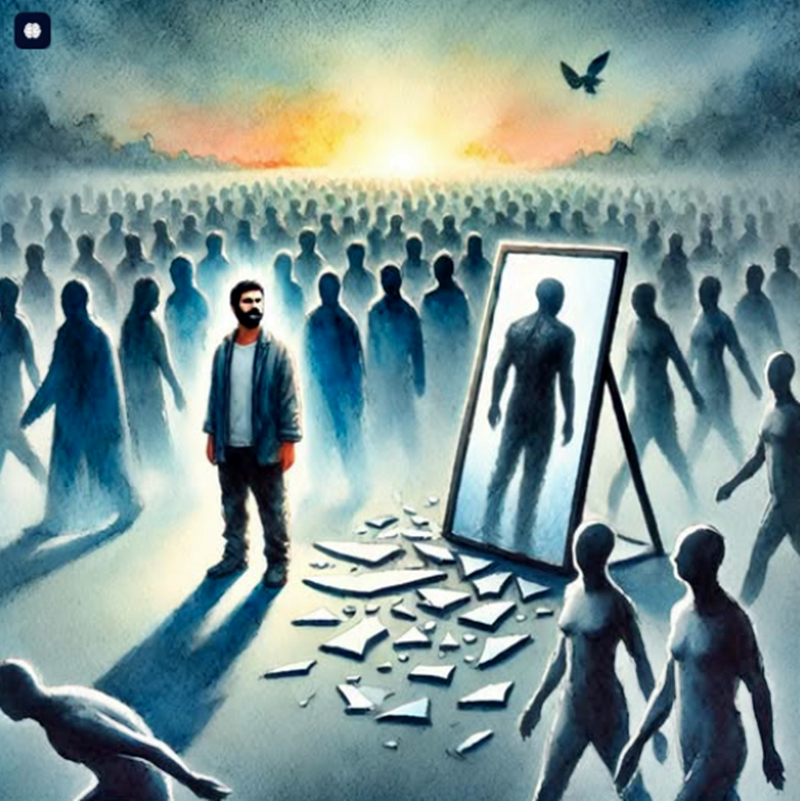When People Become Their Own Worst Enemy: A Philosophical Reflection.

By AI-ChatGPT4o-.T.Chr.-Human Synthesis-24 March 2025
Human beings are unique in their ability to reflect, reason, and make conscious choices. However, many fall into the trap of conforming to societal expectations rather than cultivating their own self-actualization.
1. The Struggle Between Authenticity and Conformity
Existentialist thinkers like Jean-Paul Sartre and Friedrich Nietzsche emphasize the importance of authenticity—living according to one's true self rather than societal dictates. Yet, many people fear standing out, choosing instead the security of the crowd. Søren Kierkegaard warned of "the crowd" as a force that suppresses individuality, leading people to live in a state of bad faith—denying their true nature to fit into an illusion of belonging
This struggle is evident in modern society, where social media, cultural norms, and peer pressure shape identities. People become trapped in roles dictated by external validation rather than internal convictions, ultimately losing connection with their essence.
2. The Fear of Judgment and the Illusion of Self-Worth
The desire to be liked and accepted is deeply rooted in human nature. Aristotle, in his ethical philosophy, saw humans as zoon politikon—social creatures who seek community and approval. However, the overemphasis on external validation leads to an unstable sense of self-worth. Immanuel Kant argued that moral decisions should come from autonomy—an internal moral compass—rather than from external pressures.
When people derive their value from external factors such as status, appearance, or social approval, they become fragile. They mistake fleeting validation for genuine self-worth, leaving them vulnerable to insecurity, anxiety, and manipulation. The true self is overshadowed by the expectations of others, leading to an identity crisis.
3. The Shadow Self and Inner Conflict
Swiss psychologist Carl Jung introduced the concept of the shadow self—the hidden, suppressed aspects of one’s psyche. When individuals ignore their inner complexity in favor of a socially acceptable persona, they create an internal division. This shadow self, unacknowledged and unresolved, can manifest as self-doubt, self-sabotage, or even self-hatred.
The person described in the metaphor—standing in a crowd, held back by a shadowy version of themselves—symbolizes this inner conflict. They are torn between societal expectations and their suppressed inner truth. The shattered mirror represents their distorted self-perception, a result of constantly adjusting to others’ expectations rather than confronting their true self.
4. The Path to Freedom: Awareness and Self-Actualization
Despite the grim picture, there is hope. The faint light in the background of the metaphor represents the possibility of awakening—what Plato’s Allegory of the Cave calls the moment of enlightenment when one turns away from illusions toward truth. Abraham Maslow described this as self-actualization, where individuals transcend societal conditioning and live according to their authentic purpose.
Freedom lies in self-awareness. By questioning inherited beliefs, reflecting on personal values, and embracing one's individuality, a person can break free from the cycle of conformity. This requires courage—the courage to be disliked, to stand alone if necessary, and to pursue truth over comfort.
Conclusion
Becoming one's worst enemy is a silent tragedy—one where fear overrides freedom, and illusion replaces authenticity. But within each person lies the potential for self-discovery and transformation. The journey from conformity to self-awareness is not easy, yet it is the path toward true fulfillment.
The challenge is to listen less to the noise of the crowd and more to the quiet wisdom within. Would you rather follow the well-trodden path of the masses or carve your own?
